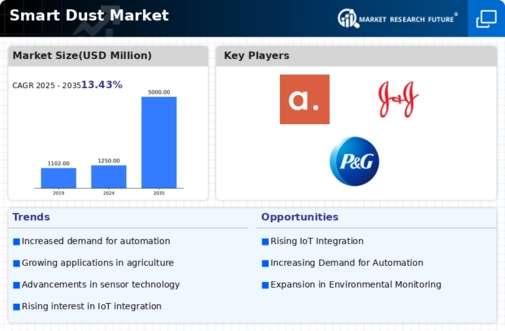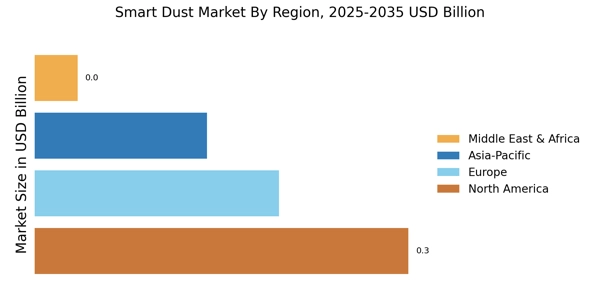Growing Demand for Smart Cities
The Smart Dust Market is poised to benefit from the growing demand for smart city initiatives. Urban areas are increasingly adopting technologies that enhance infrastructure efficiency and improve the quality of life for residents. Smart dust technology can play a pivotal role in this transformation by providing real-time data on traffic patterns, air quality, and energy consumption. As cities strive to become more sustainable and efficient, the integration of smart dust solutions is expected to rise. Reports suggest that investments in smart city technologies could exceed 1 trillion USD by 2025, creating a fertile ground for the Smart Dust Market to flourish.
Emergence of Wearable Technology
The Smart Dust Market is also benefiting from the emergence of wearable technology, which is increasingly integrating smart dust solutions. Wearable devices equipped with smart dust sensors can monitor health metrics, environmental conditions, and user activity in real-time. This integration not only enhances the functionality of wearables but also provides valuable data for healthcare providers and researchers. The wearable technology market is projected to surpass 60 billion USD by 2025, suggesting a substantial opportunity for the Smart Dust Market to expand its reach. As consumers become more health-conscious and technology-savvy, the demand for smart dust-enabled wearables is likely to grow.
Advancements in Sensor Technology
The Smart Dust Market is experiencing a surge in advancements in sensor technology, which enhances the capabilities of tiny, wireless sensors. These sensors are becoming increasingly sophisticated, allowing for more accurate data collection and analysis. The integration of micro-electromechanical systems (MEMS) has led to the development of smaller, more efficient sensors that can operate in diverse environments. As a result, industries such as healthcare and manufacturing are adopting smart dust solutions to monitor conditions in real-time. The market for MEMS sensors is projected to reach approximately 30 billion USD by 2026, indicating a robust growth trajectory that is likely to benefit the Smart Dust Market significantly.
Increased Focus on Industrial Automation
The Smart Dust Market is witnessing a heightened focus on industrial automation, driven by the need for efficiency and cost reduction. Industries are increasingly adopting smart dust technologies to monitor equipment performance, optimize supply chains, and enhance safety protocols. The ability to collect and analyze data in real-time allows organizations to make informed decisions, thereby improving operational efficiency. The industrial automation market is projected to grow to over 300 billion USD by 2026, suggesting a significant opportunity for the Smart Dust Market to capitalize on this trend. As companies seek to streamline operations, the demand for smart dust solutions is likely to increase.
Rising Interest in Environmental Monitoring
The Smart Dust Market is experiencing a rising interest in environmental monitoring, as stakeholders become more aware of the need for sustainable practices. Smart dust technology can facilitate the collection of data related to air and water quality, soil conditions, and climate change. This data is crucial for governments and organizations aiming to implement effective environmental policies. The Smart Dust Market is expected to reach approximately 20 billion USD by 2025, indicating a growing recognition of the importance of data-driven decision-making in environmental management. Consequently, the Smart Dust Market stands to gain from this trend as demand for innovative monitoring solutions increases.

















Leave a Comment